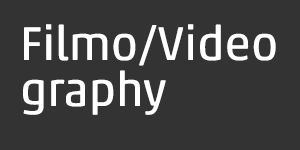Personal
From the amateur phenomenon to a mental space. The exhibition of group ZERO-61 at the forge as a place of interaction with the exhibition space, Piotr Lisowski
I would like to inform those critics that would possibly write an article about this exhibition that the photogram that is the basis for piece no. 8 is not a solirization. This effect was obtained by the use of a brush and black ink.
Wojciech Bruszewski
When Marcel Duchamp was invited by André Breton and Paul Éluard to prepare the The International Surrealism Exhibition in 1938 in Beaux-Arts Gallery, Paris, he directed the space in such a way that changed the elegant rooms of the gallery into a dark cave [1]. One entered the exhibition through a revolving door, under the ceiling he hung 1200 bags containing coal, he covered the floor with leaves and moss, and put an iron stove in the middle. As Brian O'Doherty points out - he took all those things that nobody else wanted, thus making the gallery an independent entity [2]. Four years later he did a similar thing in New York, where his Mile of String dominated the space of the exhibition.
These two classical for the history of art acts apply a number of connotations concerning the neo-avant-garde of the 1960s and 1970s. It was key to analyze certain exhibition strategies, or the whole idea of the exhibition. Hal Forster mentions that it was only the neo-avant-garde that noticed the institution of art as such, and it proceeded to creatively deconstruct it. The breaking with tradition that was to be domain of the avant-garde, took place only as a result of the neo-avant-garde which 'contested the formalism of modernism', which in turn resulted in 'a critique of space' (Michael Asher), exhibition conventions (Daniel Buren) or the status of art as merchandise (Hans Haacke), that is the multi-aspect critique of the institution of art [3]. In a similar manner Ryszard W. Kluszczyński (reflecting on Polish art) points to the significance of the 60s and the 70s, writing that 'it was then that the transition between the avant-garde, rooted still in the classical way of thinking about art in the context of the form, style and values, to the characteristic of the neo-avant-garde, anti-art of dematerialization, deformation and auto-analysis, a transition from representation and expression to action and communication, from the object to the function, from the plastic arts to the media, took place' [4].
The legendary and seemingly forgotten last exhibition of the Toruń Photography Group ZERO-61 reflects in a very sensual way the character of this transition.
1. In the old forge
The exhibition organized in May 1969 in Toruń at 32 Podmurna Street, because of the venue - a building that once war a blacksmith's works - was entitled The Forge. The exhibition was organized within the program of a national symposium about the mutual influence between plastic arts and artistic photography (10-11th of May). Due to this the opening ceremony was attended by nearly the entire photography milieu of the period. The intention of the creators was for the exhibition to be a uniform, taken over space that confronts the dilapidated and raw architecture of the building with the created, peculiar in their form artistic objects, objects found on the spot and photos dispersed on the floor, on the walls, the doors, or the ceiling. In the building the artists found a rake, a shovel, cloths, window frames, old planks of wood, and all this was of course included in the exhibition. The prepared objects included the works of Józef Robakowski Mother's Coat, (a coat filled with plaster on a hanger), The Cage (a crushed metal birdcage with a jar containing a goldfish inside) After a Human, (A Memo Board) (a wooden board with shoes, a tie, a shirt and other attributes of the human memory), The Ill Tire (a damaged car tire) and The Shirt by Antoni Mikołajczak (a shirt hanged on a window frame). The unique photo-objects include the works of Wojciech Bruszewski The Photographic Set (a number of multiplied, small pictures on the door), The Torso (two male torsos glued together), The Mascaron by Mikołajczyk (an object that is made up of several other objects: an auto portrait on canvas, an animal skull, and a spring attached to a sofa frame). Photographs that were made by putting photosensitive emulsion on canvas or any other material had a different specificity. This technique was applied by Mikołajczyk (Selfportrait) and Michał Kokot (Ahead, The Girl). It is also worth to mention some special prints, such as The Shadow by Robakowski. It is the outline of a person on a wall surface made with a modified vacuum cleaner that sprayed paint and The Footprints by Bruszewski, which is a plaster footprint of the artist in the courtyard (also in the hollow where during the exhibition fire was set). The exhibition was complemented (literally) by photographs.
The idea behind The Forge was to show a confrontation of architecture (perceived as spatial form) with the articles in it, objects and photographies. The works have been composed in such a way as to blur the boundaries between the photograph, the object and the environment. As a result, the entire exposition turned into a spatial form that connected artistic space and reality.
For the artists operating in Toruń and Łódź, The Forge was a key moment, and the attempt to end the deadlock resulted in the natural break-up of the group. This was their last shared exhibition [5], and the idea to established a new group, ZERO-69 (Robakowski, Bruszewski, Mikołajczyk Kokot, Różycki) emerged then, but it was never brought to life. Great differences in perceiving recent art began to show between the artists. Despite the often reminded fact, that The Forge was designed in Łódź, in the name of the entirely new ideas, it is possible to notice, through a certain perspective of ZERO-61's work, a continuity that is the process of development. In their history we can spot two tendencies. On the one hand, the artists were occupied with a very 'metaphorical' type of photography, which by critics was included subjective current. On the other hand, however, from the very beginning their works had tendencies to experiment and search of other ways of presenting photography. A characteristic, carnivalesque functioning of the group could be noticed. Looking at the works of ZERO-61 from the second perspective makes it possible to find in their actions a consistent process of development, which in turn led to the forge exhibition. It was an experimental attempt to create - in the words of Robakowski - a mental space. The point of departure were actions that, in a way, made Juliusz Garztecki to write a large essay in 1966 about the phenomenon of this amateur group of Toruń [6], which in turn resulted in unrest in photography circles. Rejecting traditional aesthetics for experimentation, the use of photomontage and collage, mixing photography with painting, putting it together with real objects, developing strategies for integrating photography with space, unique actionism, entering space and acting in it on a level of exhibition arrangement. ZERO-61 aimed to broaden the boundaries of photography and to transgress them. The Forge was the cumulated process.
The artists' colonization of the ruined forge space was based on creating a relation between art and reality. For this to happen, photography had to deprived of its aesthetic status, that is why it was treated like any other object, not different from a brick or a rake. Objectification took place and then, photography was dematerialized. This is the key aspect that constructs the exhibition discourse, which simultaneously constitutes a contribution to the discussion of new forms for exhibition.
2. Entering reality
Confronting photography with real objects caused that the pictures 'themselves have become objects, burnt, turned backwards, folded, glued onto a piece of clothing, put on a heap of scrap, shattered in front of the viewer' [7]. Photography plays a similar role to the other articles, or prepared objects gathered there. It was supposed to be an object and thus lose its aesthetic form. As Lechosław Olszewski remarks, the effect of this was not so much elevating these objects to the level of art, as is the case with Marcel Duchamp, as the objectification of photography [8]. Alfred Ligocki in turn points out that the exhibition gave new possibilities both to the photographic expression and the thickening of its semantic capabilities [9]. Confronting photographs with real objects carrying certain expressive value, used up, damaged, placed them in a similar position. This pointed to the physical existence of the piece. The material order of art and the material order of life were mixed up. 'The invalidation - wrote Urszula Czartoryska - humiliation of art, not just a given piece, but the whole artistic practice has become a metaphor of a far wider idea of incompatibility, lack of adaptation of life and civilization, the individual and their environment. It has become a metaphor of the incoherence of life as a whole, the insufficiency of either poetic or visual expression of an experience' [10].
The members of the group taking from reality '[...] certain objects - wrote Wojciech Roszewski in his review of the exhibition - either present directly, or depicted photographically and connecting them in such a way, they created a piece within which the components gain a new meaning. The work is, therefore, not passive, it is not an interpretation of the existing reality, it is active, creative, it brings a new reality to life' [11]. The attempt to blur the boundaries between the objects, or reality, in a broader sense, was a kind of a game that lead to the 'degradation of artistic photography' [12], but also to undermine the role of the creator. Again quoting Roszewski: 'The artistic object is fighting [...] the real object and obviously loses this fight. What we have to do with here is leveling down, self-derision, a malicious honesty.
The artist on his part, loses with the viewer, as it is not him but the viewer that gives the work the final meaning. For the viewer it is just a pretext, it provide various meanings, offers contradictory interpretations. The viewer has a chance to accept or reject. It is not the artist but the viewer that is the demiurge' [13]. Objectifying photography made it 'matter living its own life' [14], and this in turn allowed for new relations between photography and the viewer to emerge. As a principle, all the objects and photographs that were placed there, were to be destroyed, what is more, the artists themselves with their actions were destroying their works in front of the spectators [15]. Every piece of the exhibition played an important role in creating this complete artistic reality. The building (its architecture), the objects, the photographs, para-artistic activity were all to constitute a uniform, created space which is looking for a direct contact with reality [16]. Once again it is worth to refer to the aforementioned Brian O'Doherty and the idea of exhibition space as a whole. The changes in the definition of modern art brought about by the turn of the 1960s and 1970s had an impact on the perception of exhibition space. The modernist white cube, characterized by objectivism and indifference is being substituted by a space that is viewed as an integral part of the work of art. Also the viewer starts to play a different part in the space. The aim of experimenting with exhibition space is to activate the audience and to break the stereotype of the passive viewer [17]. It is worth here to call on Jan Świdziński, who reminds us that the origins of exhibitions are in the 19th century competitions for national pavilions, and exhibiting is carnivalesque by nature. It is a type of fun that contradicts the seriousness of normal behavior, it is transgressing the boundaries of everyday life into the sphere of temporary activity with its unique tendencies [18]. This carnivalesque nature is equally important to ZERO-61. Their exhibitions are often accompanied by additional attractions, non-photographic elements that constituted a type of a provocation, especially during vernissages. They used readymade objects, and absurd objects, as Robakowski called them, such as stuffed birds or crocodiles, and they put them together with photographs in the exhibitions. Józef Korbiela, a painter, photographer and the supplies officer for a regional housing association in Lipno, introduced the sort of Dadaistic game to the shows. He was a fictitious member of the group and the artists signed his name under the most 'risky', unsuccessful or controversial pieces. He participated in the exhibitions and the life of the group, mysteriously disappearing just before the vernissage.
3. The exhibition as an artistic expression
The Forge showed the dematerialization of photography in the most radical way, it showed the dominance of the building and the degraded objects over artistic photographs. These factors in Krzysztof Jurecki's opinion, will allow to describe it as one of the most interesting environments in Polish art of those times [19]. In the context of Polish photography it should be considered as another step in the process that was marked by the exhibition Closed Show (1959), which was prepared by Zdzisław Beksiński, Jerzy Lewczyński and Bronisław Schlabs, and it changd the way of thinking about presenting photographs. They began to be viewed not as whole, not as a collection of separate, autonomous pictures [20]. Zbigniew Dłubak's quest is also crucial in the matter, especially his Iconospheres (1967, 1968) that examine the relation between photography and space [21] and the problem of photographs as objects. With The Smithy the degradation of the photographic image, which was no longer needed, was most important. It was replaced by regular objects. A year earlier at Cracow's exhibition of Subjective Photography an attempt was made to gather those trends that aim for experimentation also in the form. The exhibition caused a wide discussion [22] and critics considered it a turning point that makes a break with the traditional understanding of photography and includes in with the recent experimentation in fine arts [23]. Above all, however, it was a summary of certain actions that made it clear the necessity of changes [24]. Toruń's exhibition was a sign of those changes. The Forge mark a moment where we can speak of a dissociation from the poetics of subjective photography and a slow weaving in search of new problems, problems that in a way were manifested by the exhibition Searching Photographers (1971). This process can be summarized in the words of Adam Mazur: 'Over a mere decade Polish photography witnessed a transition from a piece hanging on a wall, through photographic spatial forms to treating photography as a documentation for the creative process [...] and a means to visualize the artistic idea, media analysis and the introduction of critical photographic perspective.' [25]
The significance of the The Forge seems to be limited only to the field of photography. It refers to similar actions that deal with the problem of the exhibition. It seems an important voice in the discussion of the altering means of presenting art. The activity of such artists as Tadeusz Kantor or Włodzimierz Borowski mark one end of the scale. With Kantor, the creative process is more exposed than the work itself. Borowski, on the other hand in his Syncretic Performances 'turned over the paradigms of creation and perception', thus opposing the institutional habits, conventions and widespread definitions [26]. The other end of the scale is marked by the critics connected to the Foksal Gallery, for whom from the very beginning of the Gallery's existence, crucial were such terms as: place, exposition, or gallery as an institution. Jerzy Ludwiński's ideas can also be found here. His activity was directed against fossilized artistic conventions, and his curatorship and critical activity were aimed to reveal the processes that entangle contemporary art [27].
The Forge plays a characteristic role in this discourse. He sources of their actions were, of course, different both from the 'theoretical' Foksal Gallery and the Borowski's polemic with the modernist myth. In the case of ZERO-61 the aspect of experimenting with photography was important; and it led to the departure from the from the surface of the image and into the real. The exhibition in the forge was not unprecedented in the group's activity, it was rather the result of the experiments of its individual members. The earliest attempts to create spatial objects were undertaken by Robakowski in 1961 with his Streiner (an image of a streiner glued onto a board with a real nail in the handle). Those unique interest were visible in the group's exhibitions where the artists took their works into the public space, in the courtyards and streets, where the goal of the presentation was to confront the photographs with reality. Their objectification was emphasized. The photographs were put in selected places, they were confronted with selected real objects thus building the relation between the real world and the ostensible reality of the images. This trend had its peak at the exhibition in the forge, and after that the group broke up. Years later, Robakowski recalls: 'we got taken over by the space we found in the forge. This natural environment absorbed our artistic acts. The art vanished, it became equated with nature. All aesthetic references lost their meaning, at least in terms of this conceptual attempt. This was a wonderful beginning for many further problems we approached, with other people at Łódź Film Form Workshop' [28]. This identification with nature (the idea of entering reality) worked out perfectly with the Furniture Sale at the Red Market in Łódź (1971), where Wacław Antczak was selling the appliances and items that remained after the death of Robakowski's aunt [29].
The Forge via its character and context was involved in a unique game with the convention of constructing exhibitions, which makes it possible to view it from the perspective of an artistic expression, which as a result is an attempt to reinterpret or undermine the traditional model/understanding of an exhibition. This is a game with both the viewer and the artistic object that is being dematerialized. Photography collated with a number of various objects and the architecture of the building itself, was treated as a peculiar spatial object, and in some cases it was simply replaced by objects. This collation was accompanied by acts of destroying the works in front of the viewers. This acts, motivated by the will to blur the boundaries between art and reality were a result of perceiving photography as a material trace of reality. It was replaced by objects, and in a sense, a conceptual act. At the same time a departure from the gallery (institutional) space occurred. A departure in search of alternative stimuli aimed not on presentation, but on reception.
1 E. Filipovic, A Museum That is Not, "e-flux", 2009, no. 3, www.e-flux.com/journal/view/50, 06.09.2010.
2 B. O'Doherty, Inside the White Cube. The ideology of the Gallery Space, San Francisco 1986, p. 69.
3 H. Foster, Powrót realnego. Awangarda u schyłku XX wieku, [The Return of the Real. Avant-garde at the End of the Century] trans. M. Borowski, M. Sugiera, Cracow 2010, p. 82, 85.
4 R. W. Kluszczyński, Mechanika wyobraźnia - kreatywność maszyn. Warsztat Formy Filmowej (1970-1977), [Mechanics imagination - the reativity of machines] [in:] Warsztat Formy Filmowej [Film Form Workshop], Centrum Sztuki Współczesnej [Center of Contemporary Art] Zamek Ujazdowski, Warsaw 2000, p. 10-11.
5 Exhibition participants: Wojciech Bruszewski, Michał Kokot, Czesław Kuchta, Antoni Mikołajczyk, Józef Robakowski i Andrzej Różycki. Jerzy Wardak, a key figure for ZERO-61 was absent.
6 J. Garztecki, Fenomen Zero-61, [The Zero-61 Phenomenon], "Kultura", Warsaw 1966, no. 9.
7 U.Czartoryska, Identyfikacja zakwestionowana (O grupie Zero-61 z lat 60.), [Identification Questioned (About the Zero-61 group ] "Fotografia", Warsaw 1987, no 3, p. 24.
8 L.Olszewski, Działalność Warsztatu Formy Filmowej jako przykład strategii sztuki, [The activity of the Film Form Workshop as an ex ample of Artistic Strategy], "Artium Quaestiones",1998, no 9, p. 127.
9 A.Ligocki, W poszukiwaniu gramatyki języka fotograficznego, [In Search of the Grammar of Photography] [in:] idem, Fotograficzne penetracje [Photographical Penetrations], Kraków 1979, p. 182-198.
10 U.Czartoryska, op. cit., p. 24.
11 W.Roszewski, W starej kuźni, [In the Old Forge], "Fotografia", 1969, no 9, p. 204.
12 J.Robakowski, Moje multimedialne peregrynacje...+5 obrazów i kilka autodygresji, [My Multimedia Pereginations] [in:] Odwaga patrzenia. Eseje o fotografii [The Courage of Looking. Essays about Photography], ed. T. Ferenc, Łódź 2006, p.19.
13 W. Roszewski, op. cit. p. 204.
14 L. Olszewski, op. cit., p. 127.
15 This is visible on the exhibition's documents, where Niven photo change their place, or they are destroyed.
16 According to Marcel Bacciarlli the artists never manager to reach their aim, because the photographs dominatem and Hus they limited the perceptron of the exhibition Vide. M. Bacciarelli, W starej kuźni, [In the Old Smithy] "Fotografia", 1969, no 9, p. 200-201.
17 Vide. M. Popczyk, Estetyczne przestrzenie ekspozycji muzealnych, [Aesthetic Spaces of Museum Exhibitions] Cracow 2008, p. 220.
18 J. Świdziński, Kategorie wystawiennicze, [Exhibition Categories] "Projekt", 1971, no 1, p. 45-47.
19 K. Jurecki, Fotografia polska. Początki neoawangardy, [Polish Photography. The Beginnings of the Neo-avantgarde] "Projekt", 1988, no 6, p. 22.
20 Zob. A. Mazur, Historie fotografii w Polsce 1839-2009[The History of Photography in Poland 1839-2009], Cracow 2010, p. 407-408.
21 The Ikonosphere is concidered to be the first photographical environment in Poland.
22 U. Czartoryska, Bardzo ważna wystawa [A Very Important Exhibition], "Fotografia", 1968, no 11, p. 244-246, W. Hudon, "Wariaci" i egzaltowani, [The" Madmen" and the Effusive] "Fotografia", 1968, no 12, p. 267-276, A. Ligocki, Niefortunne zmartwychwstanie[The Unfortunate Resurrection] , "Fotografia", 1970, no 12, p. 267-269, 281-282, J. Robakowski, "Myśliwi" chwytajcie za strzelby! ["Hunters" Grab your Riffles!], "Fotografia", 1971, no 3, p. 55-56.
23 K. Jurecki, Oblicza fotografii [The Faces of Photography], Września 2009, p. 94.
24 Józef Robakowski's commentary: "This wide selection of photographs [...] made us aware of the end of thinking in the categories of photography «Creating» in recent art. Hudon was right to point out the participants of the exhibition the unnecessary decorativeness of many works, «creative eclectism», and mixing terms. From the historic point of view this was an important event, it could serve as a «springboard», from which you can jump off as soon as possible", vide: J. Robakowski, Proces kształtowania się polskiej neoawangardy... [The Process of Shaping the Polish Neo-Avant-Garde], op. cit, p. 10.
25 A. Mazur, op. cit., p. 409.
26 L. Nader, Konceptualizm w PRL [Conceptualism in the Polish People's Republic], Warsaw 2009, p. 233.
27 Zob. M. Lachowski, Awangarda wobec instytucji. O sposobach prezentacji sztuki w PRL-u [The Avant-Garde in View of Institutions. Presenting Art. in Polish People's Republic ], Lublin 2006.
28 J. Robakowski, Instalacje [Installations], Łódź 1998. The text is available on the artists : www.robakowski.net.
29 Robakowski devoted a film to his aunt: Po człowieku [After a Human].







